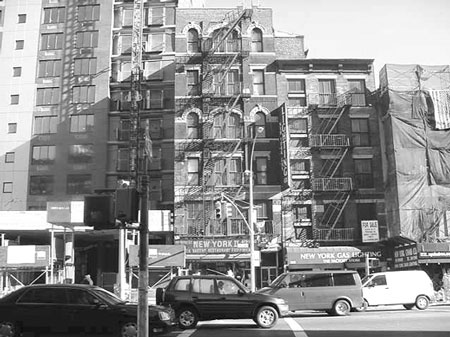By David Epstein
Andrews House, one of the few remaining Bowery flophouses and an icon of what used to be the world’s most infamous skid row, is scheduled for renovations, and some of its longtime residents are worried.
Gentrification has crept even into skid row. At 214 Bowery a penthouse rents for $5,500 a month. But across the street, Andrews House rents five-by-eight-foot rooms for no more than $10 a day. Still, current residents are concerned that one of the few constants in their lives is headed for irreparable change.
Seventy-three men, many in their 70s or older and all on Supplemental Security Income, comprise the population of permanent residents at the Andrews House. Some of them have stayed only a few years, and some who originally planned to stay only a few nights ended up settling in for 30 years or more.
In January 2002 Common Ground, a nonprofit housing organization that is headed by MacArthur Fellow Roseanne Haggerty, bought the Andrews House from the family who owned it for 50 years. Common Ground seeks to make the house a new model of a rehabilitation center for the homeless. The center will offer a comprehensive network of services for the tenants, from psychological to vocational. They will be allowed to stay only a few weeks before moving on to a more stable setting or another rehabilitation program. The current inhabitants were granted permanent-resident status as part of the deal that acquired the Andrews House for Common Ground. They generally consider themselves past the point of rehabilitation and do not want to be part of the nonprofit’s plan.
“Most of these men are like elephants,” said an Andrews House worker. “They want to go away from the pack and just wait to die.”
The worker isn’t sure residents can handle the changes heading their way. He also wonders whether the 100-year-old structure can support the planned three-floor addition.
Already the residents bristled at the changes that Common Ground has brought. “Do you want to know what the hardest thing was for these men to get used to when we moved in?” said building director Shari Siegel, who has her office in one of the tiny Andrews House rooms. “Having a woman in charge.”
With the neighborhood gentrifying around them, many of the men at Andrews House long for times past.
“The whole idea of the Bowery is it’s supposed to be rough,” said a 73-year-old man known only as “Old John With the Cane.” “Then all these liberals come down here and told you how much better your life would look if you listened to them.”
To Old John, whose foremost complaint is that he “can’t find a good drunk anymore,” the new Andrews House is less than friendly.
“I cut my finger,” he said, “and Shari wouldn’t even give me a Band-Aid because it wasn’t official procedure, so I just held my finger out and bled on her table.”
One of the first things that Common Ground did when it purchased the building for $2.25 million was to address physical problems. It put doors on the bathrooms, replaced a boiler installed in 1903 and painted some of the walls. Unpainted walls are dark brown from years of nicotine soaking into the paint.
Some residents have not been in touch with family members for years and worry that their possessions, many of which are antiques, will become Common Ground’s garbage when they die.
Despite the protestations of the remaining Bowery boys, Siegel seems quite sensitive to their concerns. She holds meetings to illuminate plans for the Andrews House, and she said that when renovations are finished, all of the permanent residents will receive rooms in the top floors, separate from the rehabilitation program.
Siegel, whose work with poor people has spanned 20 years, has been able to help some of the people that were at the Andrews House when she first arrived. She recalls meeting a man early on who she identifies only as “Mr. D.”
“He never left his room but to dash to the shower at night,” she said. “He hadn’t left the residence in two years. It took me six months just to get him to open his door.”
When Mr. D finally opened his door, Siegel found him crouched in a corner with only a towel covering his genitals. She was able to get Mr. D to go with a crisis team who found he was severely anemic and had an untreated lung disease that had immobilized him. Mr. D soon began medication, and Siegel said when she last talked to a social worker that was helping Mr. D, “She told me he had a girlfriend!”
Despite the outcome in Mr. D’s case, Siegel said that the longtime residents do not look kindly on the disappearance of their friends.
She said one man was told to leave because “he was too bad an alcoholic.” But Old John felt it was part of the push to oust the old who have made the Andrews House their home, and bring in the new who have no home at all.
The tide of change on the Bowery will not soon be stemmed, and two years from now, when the new Andrews House is scheduled to open, Old John and his buddies will be the last anachronisms left, as down-and-out becomes just out.
Also Read:




































